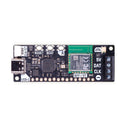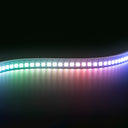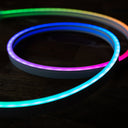Plasma 2350 W
by Pimoroni


An all-in-one, USB-C powered controller for WS2812/Neopixel and APA102/Dotstar addressable LED strips. Now with added wireless connectivity!
Plasma 2350 W is powered and programmable by USB-C and, because USB-C is capable of drawing up to 3A of power, that's enough to power a healthy chunk of LEDs. There's a useful button that you could use to switch between effects, plus a reset button and an onboard RGB LED. We've also popped a QW/ST connector on there, to make it super easy to plug in Qwiic or STEMMA QT breakouts.
The 'W' version comes equipped with a Raspberry Pi RM2 module, which gives it 2.4 GHz wireless and Bluetooth connectivity. Use it to control Plasma 2350 W remotely, hook it up to online APIs or integrate it with your home automation.
You can buy a Plasma 2350 W on its own, or in a kit with a USB-C cable and some super-cool LED stars, so you can get started lighting stuff up right away.
Features
- Powered by RP2350A (Dual Arm Cortex M33 running at up to 150MHz with 520KB of SRAM)
- 4MB of QSPI flash supporting XiP
- Compatible with 5V WS2812/Neopixel/SK6812 and APA102/Dotstar/SK9822 LEDs
- Screw terminals for attaching your LED strip.
- USB-C connector for power and programming (3A max)
- Raspberry Pi RM2 module (CYW43439), supporting IEEE 802.11 b/g/n wireless LAN, and Bluetooth
- Qw/ST (Qwiic/STEMMA QT) connector
- Reset, BOOT and a user button (the BOOT button can also be used as a user button)
- RGB LED
- Fully-assembled (no soldering required)
- Measurements: approx 61 x 22 x 12mm (L x W x H, including connectors)
- Programmable with C/C++ or MicroPython
STARter Kit contains
- Plasma 2350 W
- USB-C cable for power and programming
- 10m RGB LED Star Wire
Pinout and Schematic

Getting Started
Connecting Breakouts
If your breakout has a QW/ST connector on board, you can plug it straight in with a JST-SH to JST-SH cable, or you can easily connect any of our I2C breakouts with a JST-SH to JST-SH cable coupled with a Qw/ST to Breakout Garden adaptor.
We've also broken out the I2C, analog, UART and debug pins so you can solder things like breakouts or analog potentiometers directly to them (or solder on a strip of header and plug the whole shebang into a breadboard).
About RP2350
The RP2350 chip is the Double Quarter Pounder & Fries to the RP2040's Double Cheeseburger and can have one or more RISC-V burgers instead of either of the M33 ARMs, to stretch the metaphor.
In addition to the modern M33 ARM cores, there are sides of: more PIO capability, a variety of low power states for sipping electrons, a whole security system and some sprinklings of specialist digital video circuits to offload DVI/HDMI output.
You can expect a tasty boost in performance - our "real world" MicroPython tests are running up to 2x faster compared to RP2040, and floating point number crunching in C/C++ is up to 20x faster. The extra on-chip RAM will make a big difference when performing memory intensive operations (such as working with higher resolution displays) and even more can be added thanks to external PSRAM support.
RP2350 comes in two flavours - A (standard) and B (all the pins). The B chip has a stonking 48 usable GPIO pins, including 8 ADCs and 24 PWMs, and features on some of our new products.
-
Board Only
PIM729£13.75 -
STARter Kit
PIM758£31.25
Goodies for your Plasma 2350....
Find your perfect rainbows here! 🌈
-
 5m Flexible RGB LED Wire (50 lights)+ £10.00
5m Flexible RGB LED Wire (50 lights)+ £10.00 -
 Flexible RGB+W LED Strip (1 metre)+ £27.00
Flexible RGB+W LED Strip (1 metre)+ £27.00 -
 Neon-like RGB LED Strip with Diffuser (aka NeoPixel, WS2812, SK6812)+ £15.00
Neon-like RGB LED Strip with Diffuser (aka NeoPixel, WS2812, SK6812)+ £15.00
Shop with confidence – we've been serving the hobbyist electronics, Maker, and retro gaming communities since 2012.
- Satisfaction or refund guarantee
- Worldwide shipping via mail or courier
- 57,000+ customer reviews
- Secure website and payments



